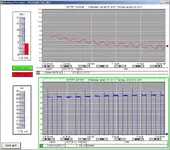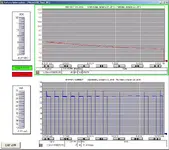Updated test...
Well, I just finished a test on a MaximalPower Li-ion 8.4V battery. I thought that battery would never die...but there's a trade-off.
The low voltage cut-off point for my tests is 7.5 volts. That's where the manufacturer of my Tesoro µMax told me I would start to see noticeable performance degradation. Your brand might have a different low-voltage value so these tests probably don't hold true to every detector out there, but it's still a good comparison.
I cut and paste the blue text below from one of my earlier posts to make the comparison a little easier to see. I also pasted the trends below.
9.6V NiMH
Average Voltage - 9.875V for 638 of 648 minutes(about 10 3/4 hours) that the circuit was loaded. The voltage dropped from 9 volts to 7.5 volts in only 10 minutes at the end.
9V Alkaline
Average Voltage - 8.25V for 760 minutes(about 12 and 2/3 hours) that the circuit was loaded. Voltage drop was consistent across entire test and there was no sharp drop off in voltage at the end.
MaximalPower 8.4V Li-ion
Average Voltage - 7.925V for 870 minutes(about 14 and 1/2 hours) that the circuit was loaded. Voltage drop was extremely consistent across entire test and there was no sharp drop off in voltage at the end.
First, a major part of a Li-ion batteries design is its ability to deliver a high amount of current very quickly on demand, when compared to an alkaline or NiMH. Example uses would be camera flashes, power tools, high-speed electric motors, etc. This can be seen in the voltage trend below. If you look at the other two voltage trends for the alkaline and NiMH you will notice the voltage fluctuate as the battery is loaded and unloaded. This kind of makes a water-wave pattern. The Li-ion battery voltage drop was almost non-existent as the load was applied and removed every hour. This is because the Li-ions design to supply higher current allows the voltage to remain much more constant. In other words, this battery didn't blink an eye when a load was applied or removed from it.
Second, this battery lasted a LONG time. Almost 2 hours longer than a 9V alkaline Duracell and almost 4 hours longer than a rechargeable 9.6V NiMH.
BUT there's a catch -
The Li-ion lasted over 14 hours before it dropped below 7.5 volts, but it only maintained a minimum of 8 volts it's first 4 hours.
The alkaline Duracell lasted over 12 hours before it dropped below 7.5 volts, but it only maintained a minimum of 8 volts it's first 6 hours.
The NiMH lasted a little less then 11 hours before it dropped below 7.5 volts, BUT it maintained a minimum of 9 volts the entire time. No, that's not a typo...the NiMH never dropped below 9 volts for the entire test until the last 10 minutes of the test.
You can see all this voltage information displayed graphically in the trends below.
So, there you have it. To get a good idea of which battery would work best for you there is a simple test. If you have a machine that tells you when you need a battery change, just remove the battery at that time and measure the voltage. This will give you a good idea of what minimum voltage the manufacturer wants to run at.
Here are all three trends -
Powerex IMEDION 9.6V 230mAh NiMH battery(MHR9VI)

Duracell DURALOCK 9V 580mAh alkaline battery(9V-6LR61)

MaximalPower 8.4V 55mAh Li-ion battery(SKU#773)

HH!






